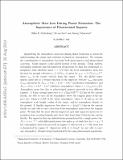| dc.contributor.author | Sari, Re’em | |
| dc.contributor.author | Yalinewich, Almog | |
| dc.contributor.author | Schlichting, Hilke E | |
| dc.date.accessioned | 2017-02-23T21:44:10Z | |
| dc.date.available | 2017-02-23T21:44:10Z | |
| dc.date.issued | 2014-10 | |
| dc.date.submitted | 2014-09 | |
| dc.identifier.issn | 0019-1035 | |
| dc.identifier.issn | 1090-2643 | |
| dc.identifier.uri | http://hdl.handle.net/1721.1/107149 | |
| dc.description.abstract | Quantifying the atmospheric mass loss during planet formation is crucial for understanding the origin and evolution of planetary atmospheres. We examine the contributions to atmospheric loss from both giant impacts and planetesimal accretion. Giant impacts cause global motion of the ground. Using analytic self-similar solutions and full numerical integrations we find (for isothermal atmospheres with adiabatic index γ=5/3) that the local atmospheric mass loss fraction for ground velocities v[subscript g]≲0.25[subscript vesc] is given by χ[subscript loss]=(1.71v[subscript g]/v[subscript esc])[superscript 4.9], where v[subscript esc] is the escape velocity from the target. Yet, the global atmospheric mass loss is a weaker function of the impactor velocity v[subscript Imp] and mass m[subscript Imp] and given by X[subscript loss]≃0.4x+1.4x[superscript 2]-0.8x[superscript 3] (isothermal atmosphere) and X[subscript loss]≃0.4x+1.8x[superscript 2]-1.2x[superscript 3] (adiabatic atmosphere), where x=(v[subscript Imp]m/v[subscript esc]M). Atmospheric mass loss due to planetesimal impacts proceeds in two different regimes: (1) large enough impactors the m ≳ √2ρ[subscript 0](πhR)[superscript 3/2] source (25 km for the current Earth), are able to eject all the atmosphere above the tangent plane of the impact site, which is h/2R of the whole atmosphere, where h, R and and ρ[subscript 0] are the atmospheric scale height, radius of the target, and its atmospheric density at the ground. (2) Smaller impactors, but above m>4πρ[subscript 0]h[superscript 3] (1 km for the current Earth) are only able to eject a fraction of the atmospheric mass above the tangent plane. We find that the most efficient impactors (per unit impactor mass) for atmospheric loss are planetesimals just above that lower limit (2 km for the current Earth). For impactor flux size distributions parametrized by a single power law, N(>r)∝r[superscript -q+1], with differential power law index q , we find that for 1<q<3 the atmospheric mass loss proceeds in regime (1) whereas for q>3 the mass loss is dominated by regime (2). Impactors with m≲4πρ[subscript 0]h[superscript 3] are not able to eject any atmosphere. Despite being bombarded by the same planetesimal population, we find that the current differences in Earth’s and Venus’ atmospheric masses can be explained by modest differences in their initial atmospheric masses and that the current atmosphere of the Earth could have resulted from an equilibrium between atmospheric erosion and volatile delivery to the atmosphere from planetesimal impacts. We conclude that planetesimal impacts are likely to have played a major role in atmospheric mass loss over the formation history of the terrestrial planets. | en_US |
| dc.language.iso | en_US | |
| dc.publisher | Elsevier | en_US |
| dc.relation.isversionof | http://dx.doi.org/10.1016/j.icarus.2014.09.053 | en_US |
| dc.rights | Creative Commons Attribution-NonCommercial-NoDerivs License | en_US |
| dc.rights.uri | http://creativecommons.org/licenses/by-nc-nd/4.0/ | en_US |
| dc.source | arXiv | en_US |
| dc.title | Atmospheric mass loss during planet formation: The importance of planetesimal impacts | en_US |
| dc.type | Article | en_US |
| dc.identifier.citation | Schlichting, Hilke E., Re’em Sari, and Almog Yalinewich. “Atmospheric Mass Loss during Planet Formation: The Importance of Planetesimal Impacts.” Icarus 247 (2015): 81–94. | en_US |
| dc.contributor.department | Massachusetts Institute of Technology. Department of Earth, Atmospheric, and Planetary Sciences | en_US |
| dc.contributor.mitauthor | Schlichting, Hilke E | |
| dc.relation.journal | Icarus | en_US |
| dc.eprint.version | Original manuscript | en_US |
| dc.type.uri | http://purl.org/eprint/type/JournalArticle | en_US |
| eprint.status | http://purl.org/eprint/status/NonPeerReviewed | en_US |
| dspace.orderedauthors | Schlichting, Hilke E.; Sari, Re’em; Yalinewich, Almog | en_US |
| dspace.embargo.terms | N | en_US |
| dc.identifier.orcid | https://orcid.org/0000-0002-0298-8089 | |
| mit.license | PUBLISHER_CC | en_US |
